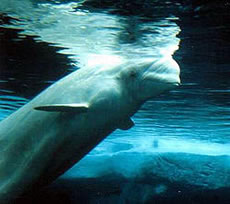Creature Profile
Also called the white whale, the Beluga whale is a cetacean, a group of creatures that includes the dolphin, the whale, and the porpoise. Adults are easily recognized by their often pure white skin, small size and lack of a dorsal fin that other cetaceans possess. They are also known for their unique ability to communicate through a variety of facial expressions. (Other cetaceans can only hold a fixed position resembling a smile, but belugas can smile, frown and whistle with their unique lips.) Since they are found in the arctic, they are equipped with a very thick layer of blubber that is five inches thick, providing insulation from the freezing water. The beluga whale can make a wide variety of sounds such as clicks, grunts, and whistles, and their sounds can be heard through the hull of ships giving them the nickname "sea canary" by early Arctic sailors.
Beluga whales can be found in northern Russia, North America, Greenland, and the Norwegian archipelago of Svalbard. In the spring, they are known to migrate north, then south in the autumn once ice in the north begins to form. They are able to dive about half a mile below the surface, but spend most of their time above swimming very slowly. In the winter months when ice is covering the surface, they use their heavy heads to create breathing holes in the ice. Belugas feed on a wide variety of fish, bottom-dwelling invertebrates and worms. They use echolocation (sounds created with their lips) to detect prey. Mating occurs in late winter or early spring, and females give birth to a single calf after a gestation period of a little over a year. The mother and calf remain close and the calf may feed on the mother's milk for up to two years. Belugas can live up to 50 years.
The exact population of this creature is unknown, but it is estimated that it numbers in the hundreds of thousands. In Canada, Alaska and Russia, belugas were once hunted heavily for their meat, blubber, and skin. Today hunting is regulated and in some areas legal for certain local people who depend on annual harvests for food. Today, habitat deterioration and pollution of its coastal habitat is the biggest threat. This species is classified as Near Threatened with the IUCN.
Wikipedia Article

|
Wikipedia Article Copyright Notice: This article is licensed under the GNU Free Documentation License. It uses material from the Wikipedia article "Beluga whale". |
May 10, 2017
Glenn, C. R. 2006. "Earth's Endangered Creatures - Beluga Facts" (Online). Accessed 7/26/2024 at http://earthsendangered.com/profile.asp?sp=10304&ID=10.
Need more Beluga facts?




